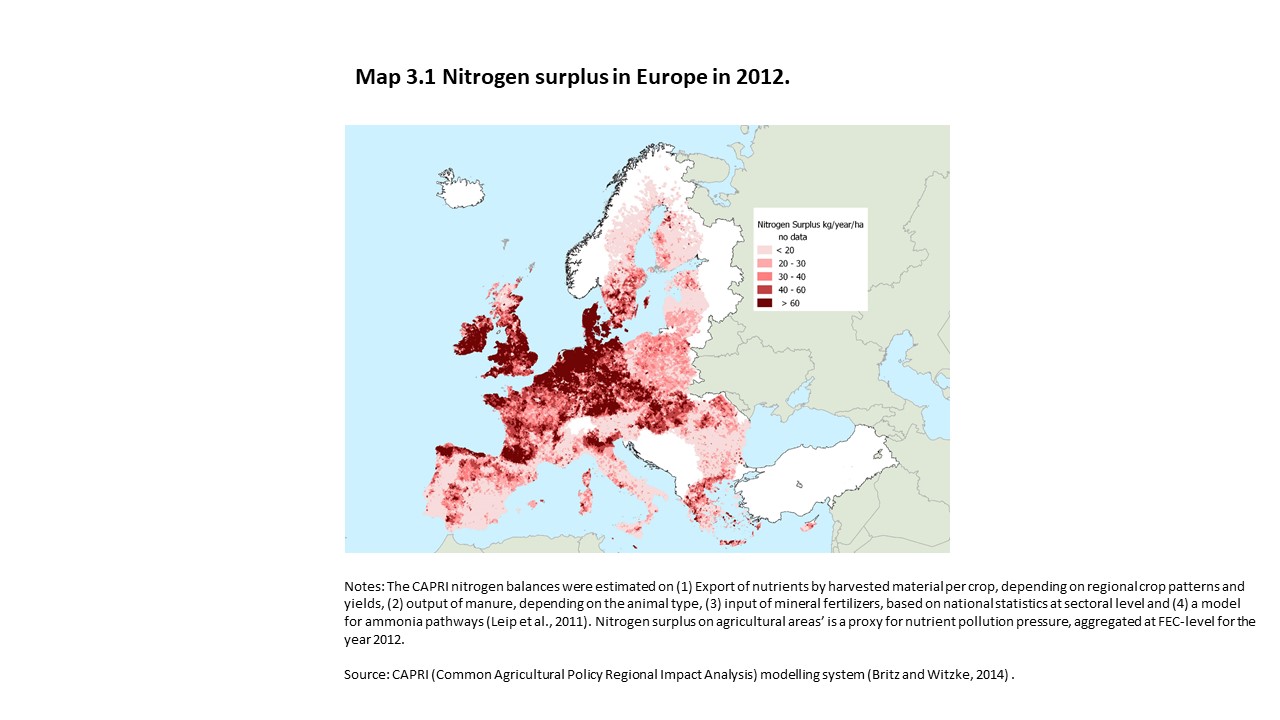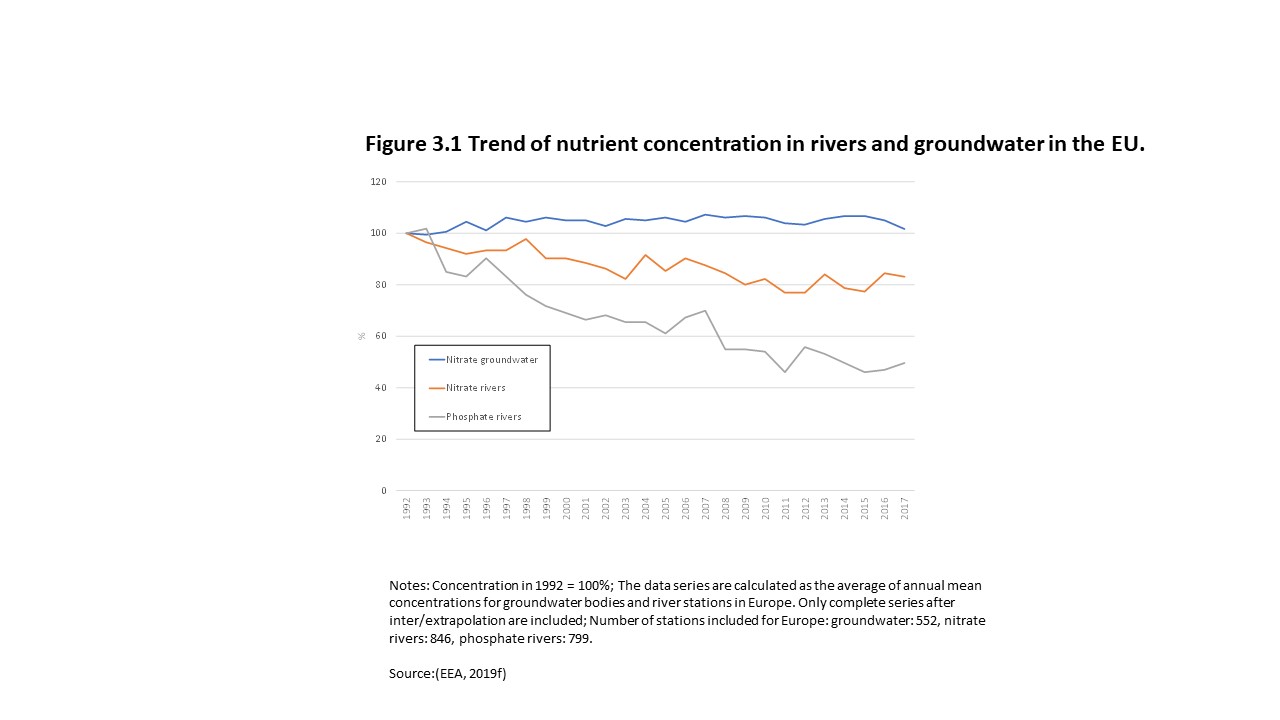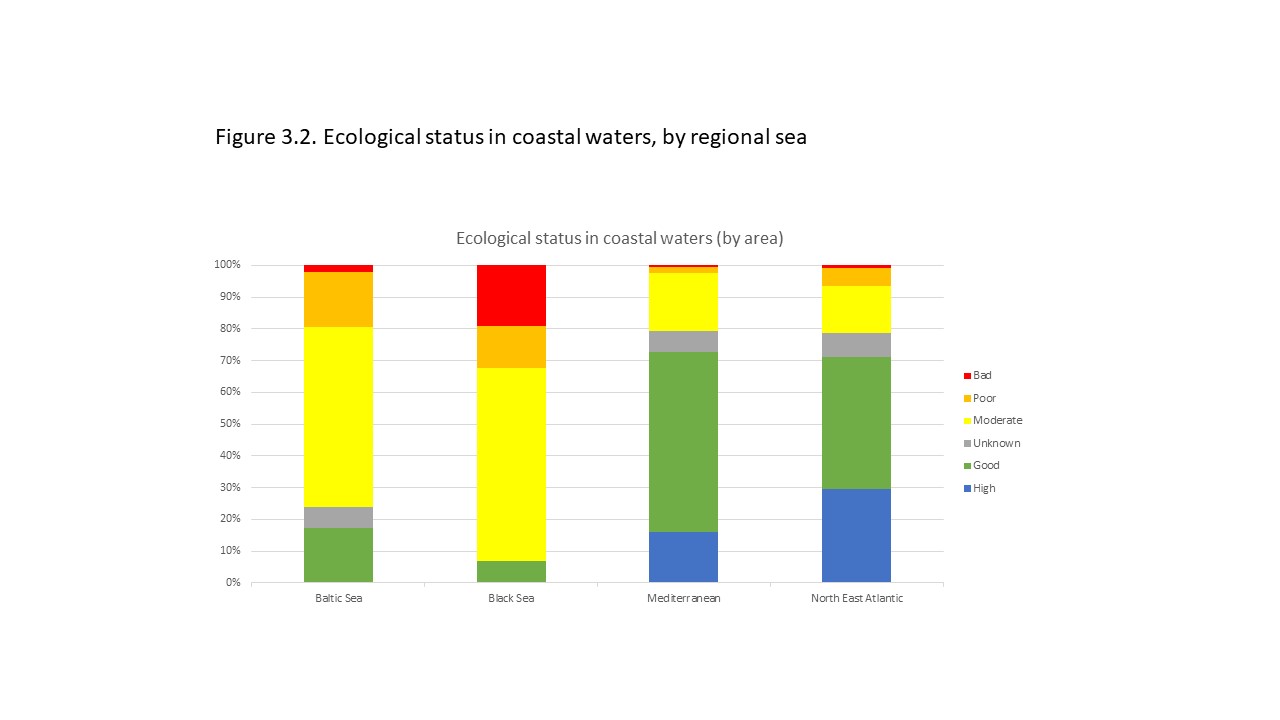Post a comment on the text below
3.1 Diffuse pollution
Agriculture is considered a main contributor of nutrients, pesticides and some metals to the aquatic environment (Chapter 2). Other substances, such as veterinary medicines also reach the aquatic environment, but in comparison very little is known about inputs or their impacts. Diffuse pollution of nutrients and pesticides remain a significant pressure to one third of surface and groundwater bodies in Europe, and are a main pressure to Europe’s seas.
3.1.1 Diffuse nutrient pollution
Excess nutrient pollution causes widespread environmental and human health problems. Nutrients stimulates undesired plant growth, and can lead to widespread eutrophication of Europe’s rivers, lakes, transitional and coastal waters and seas. By causing anaerobic conditions, eutrophication has large impacts on biodiversity. Therefore, the ecological status of water bodies is highly sensitive to nutrient pollution. High nutrient concentration also influences drinking water quality. Excess of nitrates in drinking waters can have human health impacts, such as methemoglobinemia, which prevents the normal transport of oxygen by the blood to the tissues causing cyanosis (EC, 2018)
In EU, the average nitrogen surplus from excess fertilization of agricultural areas was 49 kg N/ha in 2013-15. It decreased by 10 % between 2004 and 2015, although nitrogen fertilizer use increased during the same period. This is possible because more optimal fertilization approaches are in use, securing that inputs are much more in line with timing of plant uptake, i.e. nitrogen use efficiency has improved (ESTAT, 2017). In the same period phosphorus surplus on agricultural land also decreased from 4 kg P/ha and year to 1.2 in the time period 2004 to 2015 (ESTAT, 2017). As phosphate is effectively stored in soils, a surplus can be reduced without short term impacts on crop productivity (provided that soil is saturated).
As agricultural production is not evenly distributed and agricultural systems also differ widely across Europe, nutrient inputs are also highly variable in space. Here we use the geographical distribution of nitrogen surplus as a proxy for this variability. Nitrogen surplus exceeding 40 kg per hectar/year and which are associated with the most intensive agricultural production methods are located in Central Europe, Germany and the Netherlands in particular, but also in Denmark, the UK and Ireland, and parts of France, Spain, Italy and Hungary (Map 3.1).
The amount of nutrients that end up in streams and the rate at which this occurs, depends crops, specific application strategies, and on a wealth of local geographical factors, such as soil quality and permeability, water availability, groundwater residence times, catchment topography, presence of natural and constructed buffers and wetlands, and climate. Together these factors determine the catchment nutrient residence time. These factors also determine the specific transformations that take place. One of these, denitrification is particularly important as it returns reactive nitrogen (such as nitrate) to the more stable atmospheric N2, which may account for considerable nitrogen removal. Ultimately, these processes determine the share of nutrients that end up in rivers, lakes, transitional, coastal waters and Europe’s seas.

In Europe, significant efforts have been made towards reducing point source emissions, and especially the implementation of urban waste water treatment has led to declining concentrations in rivers of phosphate associated with industrial and urban waste water pollution (EEA, 2019c). In contrast, concentrations of nitrates more closely linked to agricultural diffuse pollution are declining much more slowly in rivers and not at all in groundwater (Figure 3.1).
These trends are also reflected in results of the second river basin management plans compiled under the Water Framework Directive. In them, significant pressures linked to diffuse emissions were identified for 33% surface water and 22% of groundwater bodies in EU and Norway, and the pressures in close to 70% of those waterbodies were specifically linked to agriculture (EEA, 2018f). This assessment is made when surface water bodies fail to achieve good ecological status or when groundwater bodies fail to achieve good chemical status. Groundwater bodies primarily fail to achieve good chemical status due to elevated concentrations of nitrates in groundwater.

Diffuse pollution from agriculture and the associated eutrophication is a major environmental pressure in Europe’s coastal waters and seas, especially in the Baltic and Black Seas where only 10% and 15% of coastal waters achieve good ecological status (Figure 3.2). A recent assessment of eutrophication in Europe’s seas showed that 99% of the Baltic Sea area, 53% of the Black Sea area, 12% of the Mediterranean area and 7% of the North East Atlantic area were assessed as problem areas with respect to eutrophication (EEA, 2019e). The Baltic and Black Seas are semi enclosed and highly stratified seas with hydrodynamical conditions that hamper water exchange with surrounding water. Both have extensive dead zones as a consequence. The large problems linked to eutrophication in the Baltic Sea has led to international collaboration in context of the Baltic Sea Action Plan, also adopted as a European Regional Strategy (EC, 2009, Box 3.1)

You cannot post comments to this consultation because you are not authenticated. Please log in.



Previous comments
Map 3.1 - Please, share source of information. Or is it by EEA?